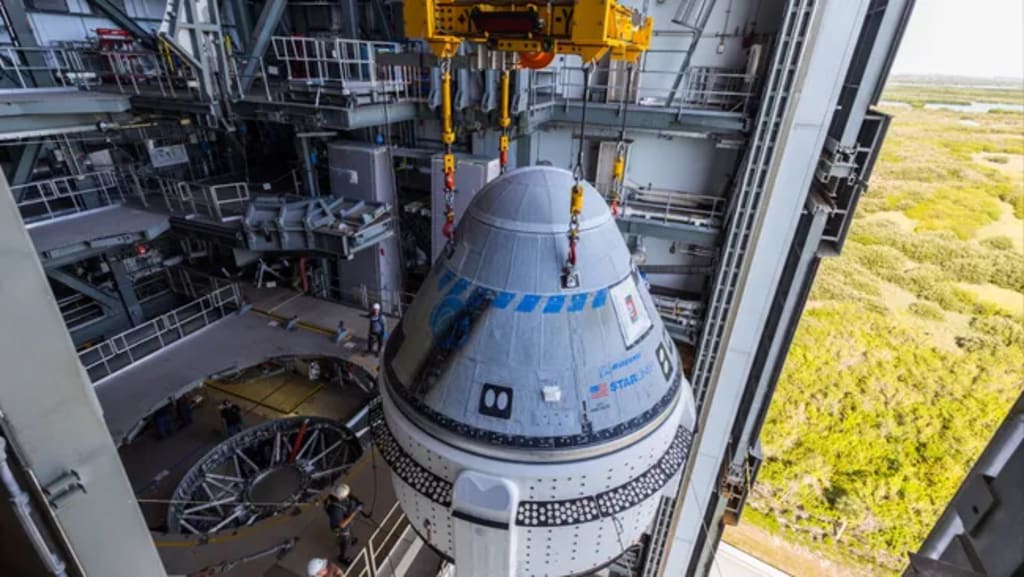'It's so complicated:' Boeing Starliner teams diagnosing helium leak ahead of June 1 astronaut launch
Boeing Starliner Teams Diagnosing Helium Leak Ahead of June 1 Astronaut Launch As Boeing's Starliner spacecraft prepares for its historic first astronaut mission, teams are working tirelessly to address a small but complicated helium leak that has added unexpected challenges to the mission timeline. Scheduled for June 1, the Crew Flight Test (CFT) aims to transport NASA astronauts Butch Wilmore and Suni Williams to the International Space Station (ISS) for a week-long mission. Both astronauts are seasoned professionals and former U.S. Navy test pilots.

Boeing Starliner Teams Diagnosing Helium Leak Ahead of June 1 Astronaut Launch
As Boeing's Starliner spacecraft prepares for its historic first astronaut mission, teams are working tirelessly to address a small but complicated helium leak that has added unexpected challenges to the mission timeline. Scheduled for June 1, the Crew Flight Test (CFT) aims to transport NASA astronauts Butch Wilmore and Suni Williams to the International Space Station (ISS) for a week-long mission. Both astronauts are seasoned professionals and former U.S. Navy test pilots.
The complexity of space missions cannot be overstated, and this recent development with Starliner exemplifies the meticulous care and coordination required. "It's so complicated. There's so many things going on. We really just needed to work through it as a team," said Ken Bowersox, associate administrator for NASA's Space Operations Mission Directorate and a former astronaut, during a teleconference on May 24. This issue has slowed down the flow of updates, as the team prioritizes resolving the problem safely and effectively.
The helium leak was discovered after the Starliner spacecraft's May 6 launch attempt was scrubbed just two hours before liftoff due to an oxygen relief valve issue on the Atlas V rocket. United Launch Alliance (ULA), the rocket's manufacturer, replaced the problematic valve by May 12. However, the helium leak in Starliner’s propulsion system then surfaced, leading to further delays. This leak, though small, is significant because it could affect the pressurization needed for orbital maneuvers.
The leak is located in one of the Aerojet Rocketdyne reaction control system (RCS) thrusters, specifically in a manifold that controls the thruster valves. NASA's Steve Stich, program manager for the agency's commercial crew program, explained that the issue prompted a thorough review of the manifolds and the helium system. While helium is a non-reactive gas and not an immediate risk to the launch, it is crucial for the spacecraft's small maneuvers in orbit and for its return to Earth.
During the teleconference, NASA and Boeing officials reassured that if a similar leak occurred in space, they would have ways to manage it. They emphasized that even fully certified spacecraft systems can experience unexpected hardware failures. "There's no human-rated vehicle that doesn't experience this kind of anomaly," noted Boeing’s Mark Nappi, vice president and program manager of the company's commercial crew program. He cited examples from SpaceX's Crew Dragon and the retired space shuttle program to highlight that such issues are part of the spaceflight landscape.
A delta flight readiness review is scheduled for May 29 to assess the situation and the modifications needed, including a potential change in the deorbit burn process. This review is crucial because the interim human certification document for CFT has been adjusted in response to the helium leak. NASA plans to hold another update call with reporters on May 30.
Despite these challenges, the launch is still on track for June 1, with backup dates available in early June and later in the summer. If the helium leak proves to be more problematic than anticipated, the team is prepared with several contingency plans. For instance, the current system can handle additional thruster leaks, and engineers have tested the spacecraft through various pressure changes, finding the leak to be relatively stable.
The astronauts, Wilmore and Williams, have been in quarantine for about a month and are ready to adapt to the changing schedule. They will return to Kennedy Space Center in Florida a few days before the planned launch. Their resilience and experience in handling developmental programs like Starliner are invaluable in navigating these delays.
As Boeing and NASA work through these final pre-launch hurdles, the broader mission of maintaining reliable transportation to the ISS with both Boeing's Starliner and SpaceX's Dragon remains a priority. The successful launch and operation of Starliner will mark a significant milestone in commercial crewed spaceflight, ensuring diverse and dependable options for reaching the ISS.
The path to space is fraught with challenges, but each step forward brings us closer to expanding humanity's presence in space. The upcoming mission will be a testament to the dedication and ingenuity of the teams at Boeing, NASA, and their partners. As they continue to address the helium leak and finalize preparations, the world watches with anticipation for the historic moment when Starliner finally carries astronauts aloft.
About the Creator
Raju Moses
I am a fascinating Writer of all available trending topic in the world.
Enjoyed the story? Support the Creator.
Subscribe for free to receive all their stories in your feed. You could also pledge your support or give them a one-off tip, letting them know you appreciate their work.





Comments (1)
Hey, just wanna let you know that this is more suitable to be posted in the FYI community 😊